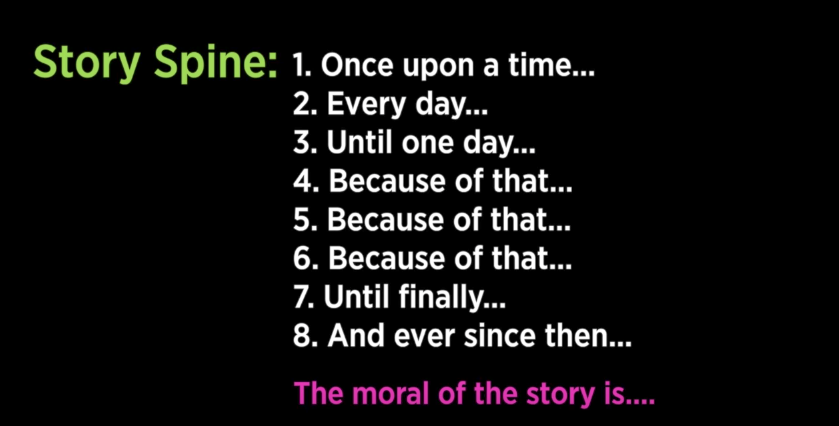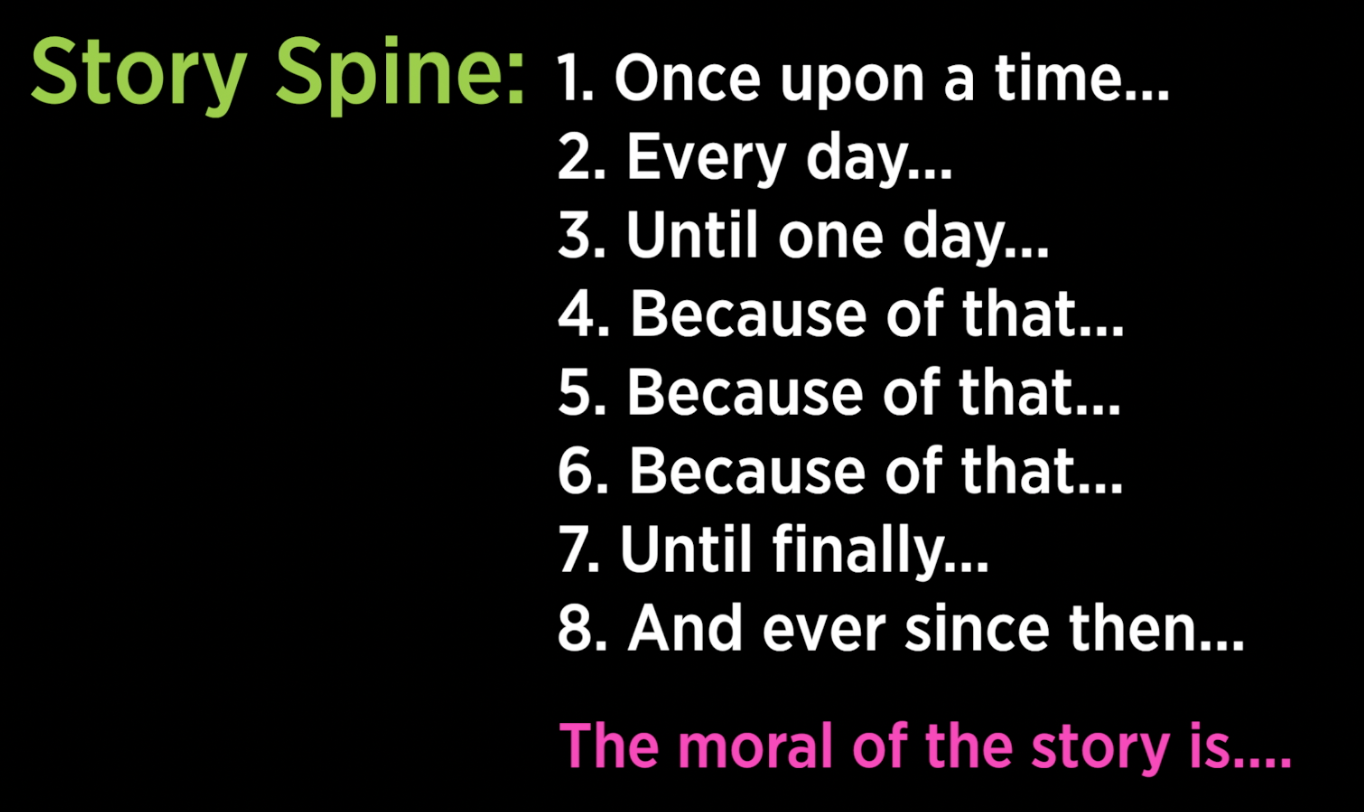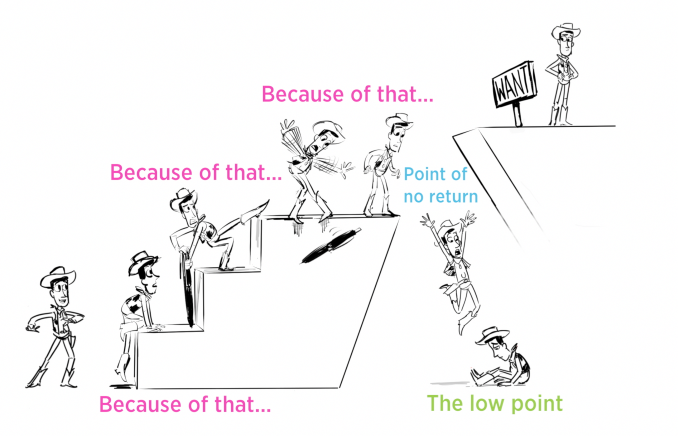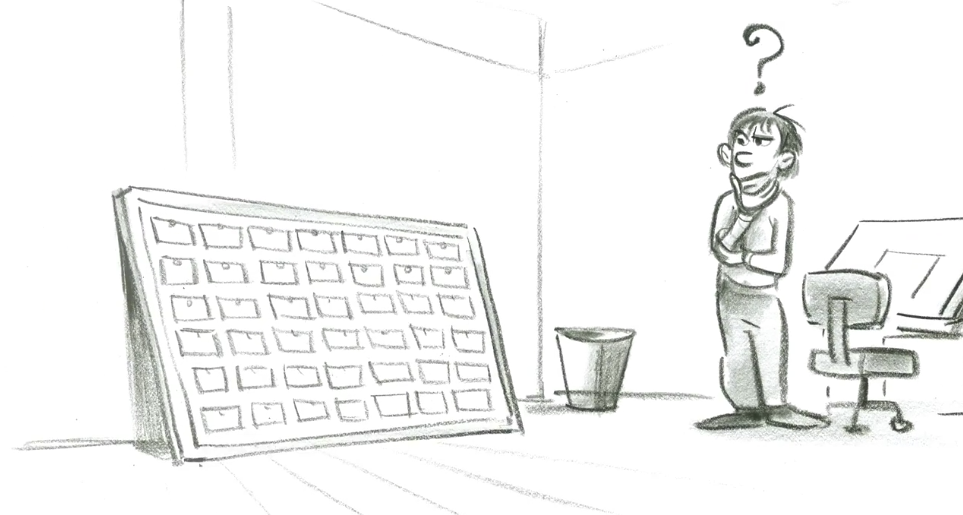Due June 14th by 11:59 pm
Every story that is told has a foundation, or structure. For example, one of the most basic story structures is “it begins, something happens, and it ends.” But a story’s structure can be complex, and if used well you’re not even aware of it. In this lesson you’ll learn how Pixar structures their films, and you’ll start laying the foundation for your own stories.
Introduction to Structure
Activity 1: Beats

Part A: Beats can show the most important moments in your story. They show WHAT is happening, not HOW. Choose a format (outline form, using index cards, sketchbook, etc.) to identify and describe the beats that are part of the structure in each of your three favorite films.
Part B: Play the “Story Spine game” with a group of people. Go around in a circle and improv the development of a story. Start with “once upon a time” and have one person at a time spontaneously fill in the blank for each line.
Part C: Develop a story spine for your own film idea. Try sharing your spine with someone and iterating a few times…
Go to your Google Drive folder and create a Google Doc to write your ideas and responses.
Theme
Activity 2: Theme

Part A: Describe the moral or theme of your three favorite films. Can you identify the lesson that the main character(s) learns by the end of the film?
Part B: Think of a story from your own life. What was the moral of your story? What did you learn and why?
Part C: Return to the story you are developing and try the following:
- Brainstorm ideas for the moral in your own story (return to the needs of your main character from the Character lesson)
- Try retelling your original story spine in order to reinforce (clarify) the moral at the end.

Go to your Google Drive folder and create a Google Doc to write your ideas and responses.
Act 1
Activity 3: Act 1

Part A: Identify the First Act in your three favorite films.
- Who is/are the main characters, and why do we care about them?
- Where and when does the story take place?
- How do we learn what type of movie it is?
- What is the inciting incident? (how is the world disrupted?)
- What or who is the antagonist?
Part B: Now dream up what you want to present in the first act of your own film.
- Ask yourself Who/What/When/Where
- Try fitting it into the first three steps story spine, and flesh each step out with 3-4 sentences….
Go to your Google Drive folder and create a Google Doc to write your ideas and responses.
Act 2
Activity 4: Act 2

Part A: Identify the Act 2 in your three favorite films.
- What is the want/goal of the main character(s) at the start of Act 2?
- What (if any) is the point of no return or turning point (when the character learns something and changes their path)?
- What (if any) is the low point?
- What did the character learn by the end of the second act?

Part B: Now develop the information you want to present in Act 2 of your own film.
- What is the want/goal of your main character(s) at the start of Act 2?
- Why does your character reach a low point, if any?
- Describe the point of no return or turning point (where your character learns something new and realizes their needs.)
- Try fitting this into the Act 2 steps of the story spine (fill each step out with 3-4 sentences.)
Go to your Google Drive folder and create a Google Doc to write your ideas and responses.
Act 3
Activity 5: Act 3

Part A: Identify Act 3 in each of your three favorite films.
- What was the crisis?
- How is it resolved?
- How does the main character demonstrate that they learned what they needed?
- What was the theme or moral?
- Was the character arc emotionally satisfying? Why or why not?

Part B: Now develop the information you want to present in Act 3 of your own film.
- What is the crisis?
- How could it be resolved?
- How will the main character demonstrate that they learned what they needed?
- What is the theme or moral?
- Do you think the audience will find the ending emotionally satisfying? Why?
Go to your Google Drive folder and create a Google Doc to write your ideas and responses.
Advice on Story Structure
Glossary: Story Structure
Here’s a list of definitions introduced during this lesson.
- External feature: the clothes, design or look of a character.
- Act One: consists of introducing the characters, introducing the story, and getting a landscape of where the story is trying to go
- Act Two: consists of the choices and actions your main character makes as they attempt to overcome the escalating obstacles in pursuit of their goals
- Act Three: consists of the final test of the protagonist and the resolution that follows; where the story comes together
- Antagonist: is a force that gets in the way of your character’s wants and needs; typically “the villain”
- Final Crisis/Climax: the most intense moment of the film for the protagonist who should be in danger of losing everything they value most; “the ultimate test”
- Inciting Incident: an event which leads to a key obstacle your protagonist faces and sets the rest of the story in motion
- Low Point: the point in the story when it seems like everything is lost for your main characters
- Moral: the lesson that the main character learned at the end of the story
- Point of No Return: a choice which the main character can never turn back
- Resolution: the return of the world and characters to a calmer place, perhaps a more complete or better version of themselves
- Story Beats: the most important moments in your story Story Spine: a tool used to develop story beats following a simple pattern
- Structure: the ordering of the events, or a sequence of beats, in the story
- Theme: the idea that connects all the events in the story and is connected to the moral
* Effective communication among peers is extremely important, and using the correct terminology will help you get your ideas across more effectively. Create a Google Doc in your Google Drive and name it The Art of Storytelling Glossary. Each week copy and paste the new glossary terms into that document and focus on learning those terms the way they’re used in the animation industry.
Animating a walk cycle
Due June 14th by 11:59 pm
When you complete this module’s activities, upload your doc using the link below:
https://www.dropbox.com/request/96KRIoem747kOAe7PHBc
All Khan Academy content is available for free at www.khanacademy.org